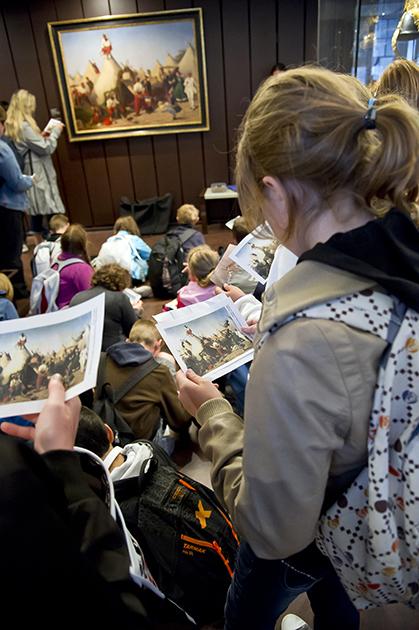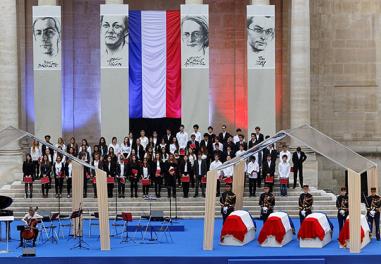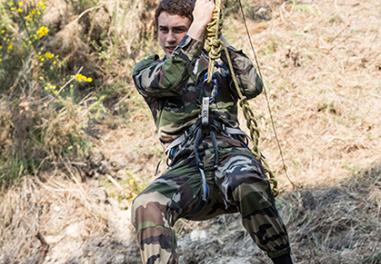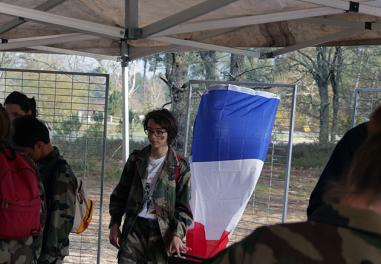Musée de l’Armée
To complement classroom learning, students also learn about military history, remembrance issues and the challenges of defence through the heritage of the Ministry of the Armed Forces. The Musée de l'Armée at Les Invalides receives regular visits from school parties.

Under its articles of association, the Musée de l'Armée has a part to play in raising young people's awareness about the duty of defence. It contributes to the teaching of both civic education and history by means of a series of visits offered to teachers and their pupils.
Guided tours through the chronologically ordered rooms of the permanent exhibition introduce and illustrate four subjects which put in context certain important historical choices in terms of defence policy in the modern and/or contemporary era. First, the French people and compulsory military service, from the Revolution to the Great War, with the recruitment of troops under the Revolution and the Empire, the emergence of the soldier-citizen and conscription, then, after the shock of defeat in the Franco-Prussian War of 1870-71, the introduction of universally compulsory military service for men (laws of 1872, 1889 and 1905); the First World War was the apogee of the conscription army. Second, the failure of a strictly defensive strategy, in the interwar period, as symbolised by the Maginot Line in 1939, culminating in the disaster of 1940 and its tragic consequences, both military and political. Third, the complex relationship between diplomacy and defence, with a look at the creation and role of alliances, from 1871 to 1914 and 1919 to 1939. Lastly, the fundamental issue of the shift towards total war from 1914 to 1945. The aim is for students to gain a grasp of the growing involvement and targeting of civilians in the two global conflicts of the 20th century, in their economic, scientific, technical and ideological dimensions.
Among the Musée de l'Armée's themed areas is the Historial Charles de Gaulle, which offers numerous possibilities. Its rich audiovisual archives and multimedia devices offer a means of looking at the issues of French defence during a crucial period, immediately preceding the present day, and shed light on many aspects: “France and the challenges of defence in the second half of the 20th century, from the Second World War to the Cold War” and “The Fifth Republic and the adoption of nuclear deterrence”. The Historial's director is also actively involved in planning the Concours national de la Résistance et de la Déportation, a competition for middle- and high-school students.
Finally, let us not forget the setting of the Hôtel national des Invalides, France's military pantheon. All these options are supported by copious visitor documentation, produced by the Department for Historical Research, Educational Actions and Outreach (DRHAPM), in conjunction with the Musée de l'Armée's conservation department, and available on the museum website. The DRHAPM is also involved in more specific projects, in dialogue with teachers, schools and other heritage institutions. Two recent examples are: two themed visits organised in conjunction with the Mémorial de la Shoah, one for primary school pupils (“Life and survival in Vichy France”), the other for middle-school classes (“Propaganda and counter-propaganda during the Second World War”). Meanwhile, in 2017 a partnership agreement was signed between the Musée de l'Armée, the Collège d'Artagnan in Nogaro (Gers) and the Cercle Sportif de l'Institution Nationale des Invalides, to create a course on defence and global security.
Read more
Musée de l'Armée website: www.musee-armee.fr
Enquiries and bookings: jeunes@musee-armee.fr
Articles of the review
-
The file

Teaching about defence
“Defence! It is the State's primary raison d'être. It cannot neglect it without destroying itself.” So said General de Gaulle, in Bayeux, on 14 June 1952. By ending compulsory military service in 1997, the French parliament gave the national education service the task of introducing young people to ...Read more -
The event

30th anniversary of the ‘academic triads’
The challenges currently facing the defence and education sectors, and the doubts and uncertainties affecting French young people, are evidence of how the trinômes académiques, or 'academic triads', are more important today than ever before....Read more -
The interview

The spirit of defence
Engagement officer General Christophe de Gouttes assists the commander of the Southwest defence and security zone in his functions. His is a role unique to this zone which covers the entire Nouvelle-Aquitaine region, of which he is also army commander....Read more

